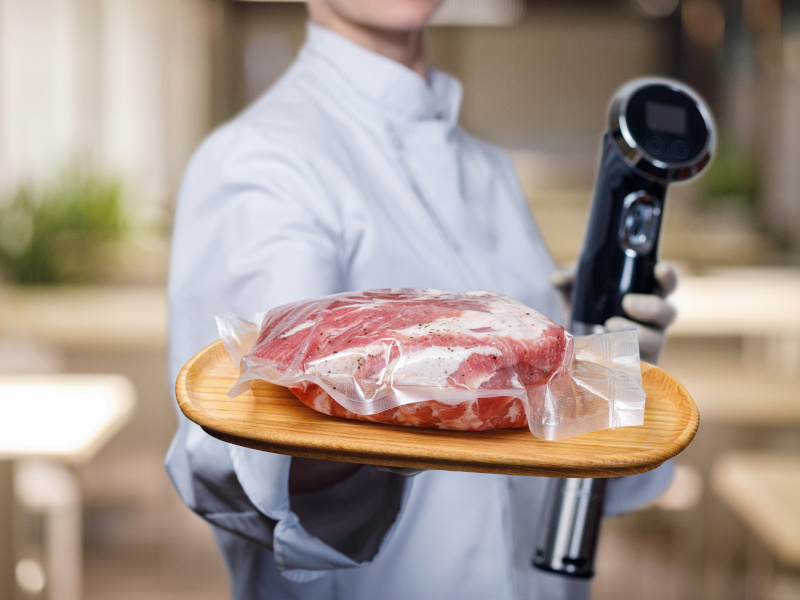- Step 1: The Basic Principles of Vacuum
- Step 2: The Storage
- Step 3: The Appearance, Taste, and Smell of the Product
- Step 4: The Summary
Step 1: The Basic Principles of Vacuum
The technology of “sous-vide” is quite old because it is Blaise Pascal, mathematician, philosopher, and French writer, who 1st did experiments on the existence of atmospheric pressure and, therefore, the presence of “vacuum.” The first tests of product packaging and cooking in the packaging date back to 1968, with the Gatineau process on the sterilization of potatoes in their final packaging.
Thanks to the fact that vacuum packets are a barrier to oxygen, which causes the breakdown of proteins, lipids, and carbohydrates, caused by bacteria and enzymes naturally present in food, the shelf life of food is increased. Perishable foods stay fresh longer because the development of microorganisms is reduced. The principle of vacuum is therefore elementary:
Step 2: The Storage
You can store your meat in a refrigerator which provides a much longer shelf life than fresh or in a container (about 21 days) between 35.6 °F (2 °C) and 39.2 °F (4 °C). Meat with bones can be stored for a shorter time because the bones are going off more quickly.
You can freeze your meat up to 4 to 6 months at around 0 °F (-18 °C). Note that vacuum products are neither damaged nor burnt by frost. The vacuum-sealing the meat prevents the pieces from drying out, even during freezing. When defrosting, the meat is not soaked with water.
The label of each piece of meat indicates the date of the packaging and the date of consumption limit. This recommended storage period mainly depends on storage conditions. It is essential to be rigorous about the storage temperatures of your vacuum-packed meat.
Meat should be stored in the coldest compartment of the refrigerator: near the back wall or in the lowest possible shelf. The temperature of your refrigerator should be ideally between 35.6 °F (2 °C) and 39.2 °F (4 °C). Please note that frequently opening and closing your refrigerator does not always help these conditions. It is also vital to retain the conditions during the transport of your vacuum-packed meat because it must be kept between 2 °C and 4 °C too.
Step 3: The Appearance, Taste, and Smell of the Product
Vacuum packaging keeps the meat in excellent conditions without affecting the taste and smell of the meat. However, some phenomena related to the lack of oxygen can be surprising, and should, therefore, be explained to people who come across meat under vacuum for the first time.
The Color of the Meat
When the meat is longer without any contact with oxygen, it loses its color. It changes from a bright red on contact with air to a dark purple when vacuum packed. This aspect is quite common, and it results from the change of state of the pigment responsible for the red color of the meat: myoglobin. This change in color is reversible by oxygenation, so the meat resumes its natural color 30 minutes to 1 hour after opening the package. You have to let the product “breathe” before preparing it.
The Smell of Meat
When the bag is opened, the smell of the meat is a little more “pronounced.” This is quite normal because the vacuum storage concentrates the aromas, which escape suddenly when the packaging is opened. This stronger smell can surprise when we are not used to it. It can also appear reinforced if the meat is aged meat. We advise you to remove the meat from the packaging at least 20 minutes before cooking for small pieces, and up to several hours for large pieces or steaks. The more time the meat has to re-oxygenate, the better its taste.
Step 4: The Summary
Practical Tips
It is desired to regularly check that the packagings are not damaged and that your products are correctly vacuum-sealed. Particular attention must be paid to the meat with bones because they can pierce the pocket during transport or handling. Meat that is no longer under vacuum must be consumed as soon as possible. The date indicated on the bag is no longer valid! If in doubt about the packaging, it is best to freeze the product or cook it quickly.


